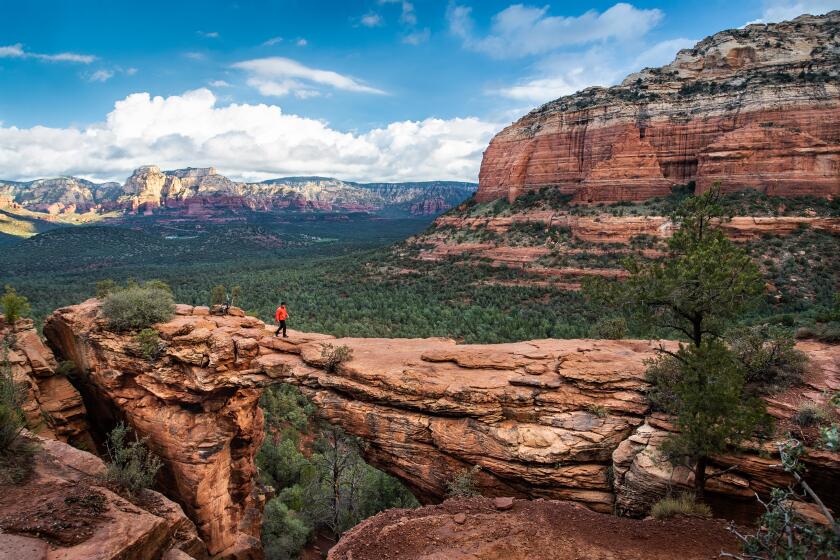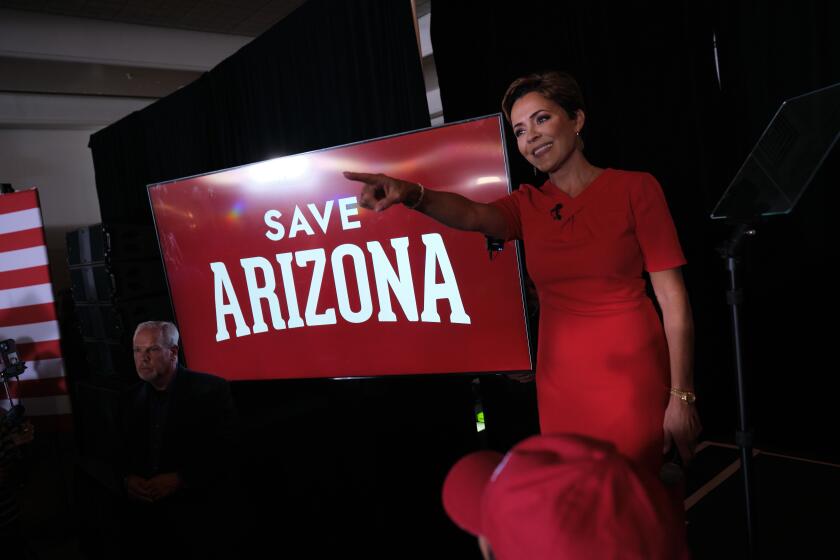
- Share via
You’d think that a town dependent on tourist dollars would never stop advertising itself. But in Sedona, Ariz., with wealthy residents weary of visitors jamming up their roads and a bitter rift over what constitutes “the right kind” of visitors, that’s just what has happened.
After the onset of the COVID-19 pandemic, Sedona’s city government and the Chamber of Commerce made a joint agreement to quit advertising the town in glossy national travel magazines and doing social media posts targeted at rich people, since the marketing money would be wasted during the international shutdown.
The pause sparked infighting, which has since escalated. In April, the Chamber of Commerce’s board voted to end its tourism contract with the city over the council’s refusal to fund “destination marketing.”
Red Rocks Country has long beckoned weekend travelers from L.A. But many locals believe tourists are loving their town to death.
This experiment has not yielded the expected serenity.
Instead, Sedona has filled up with “wayward and lost tourists,” in the words of Christopher Fox Graham, managing editor of the Sedona Red Rock News. Without such destination marketing, he wrote, “Sedona has been beset by day travelers from Phoenix, Tucson and Las Vegas, and Californian overnighters who roll into town with little guidance on where to stay, eat, shop or explore other than what they saw on Instagram.”
One of the reasons for these visitors from nearby cities — and one of the headaches for the many retirees who would prefer that Sedona be more “Slo-dona” — is that more than a third of the city’s homes are used for short-term rentals.
That fact led the City Council to require, starting in February, an annual permit for lessors and mandatory sex offender checks on renters to prevent, in the words of one council member, “orgies in nice areas.”
They’re wealthy and live in posh locations. Here’s how the coronavirus outbreak affects them.
The city of Sedona has also offered landlords who can be persuaded to rent their homes to locals a subsidy up to $10,000. But few who work the low-wage tourism jobs can afford to live in Sedona. Neither can young families, which is why there is only a single elementary school, with declining enrollment, in a town of more than 11,000. “Basically, people feel they live in a gas station,” observed resident Sean Dedalus.
The hard irony of the current controversy is that Sedona has long been defined by visitors and other outsiders.
Sedona occupies a valley that had been a home for the Yavapai-Apache people for seven centuries before the U.S. Cavalry chased them away as a side campaign to the Apache Wars of the 1870s.
When early settler J.J. Thompson arrived in Oak Creek Canyon, he found irrigation and fruit orchards that had been tended by people who were forced to leave in a hurry. He simply took them over for himself, joined later by Manuel Chavez, a former U.S. Army scout and rancher, and the dapper storekeeper T. Carl Schnebly, who named the post office for his wife, Sedona.
Through most of the last 150 years, Arizona has been a geography of personal reinvention, ambitious and fraudulent schemes and hype that exceeded nature’s limits.
The name Sedona gained cultural currency in the golden age of the pulp Western, after Zane Gray set his 1922 novel “The Call of the Canyon” in nearby Oak Creek Canyon, inspiring a quickie silent movie. Hollywood soon found the wine-colored spires and juniper trees just as sublime as Monument Valley, not to mention closer to California. John Wayne came to Sedona to film “Angel and the Badman,” leaving behind a movie set that later became a subdivision where all the streets were named after famous oat operas: “Broken Arrow,” “Copper Canyon,” “Last Wagon” and “Johnny Guitar.” Elvis Presley came here, too, in 1968, to shoot what is widely regarded as the worst movie he starred in: “Stay Away, Joe.”
In the late 1950s, Sedona really found its tourism sweet spot. A real estate agent named Mary Lou Keller founded the Church of Light in her office and proclaimed the working-class ranching town a global center of spiritual energy. She may have invented this to attract home-buyers who favored crystals and tarot cards, but the seekers arrived in force, turning Sedona into a cauldron of the New Thought movement that had gripped Los Angeles in the 1920s.
Today, an estimated 200 small businesses in Sedona cater to visitors intrigued with the theology of earth energy: bookstores, crystal emporiums, sweat lodge retreats and other enterprises that come and go like sunbeams. One Chamber of Commerce survey found that 37% of visitors come for some kind of spiritual experience.
Often, they visit spots in the surrounding Coconino National Forest that have been proclaimed as “vortexes” of energy. Forest Service employees are constantly breaking up unauthorized rock arrangements that the metaphysical pilgrims say are “medicine wheels.”
Whatever their motivation, people keep catching what local Realtors call “the red rock fever” and keep coming to Sedona — and adding to the traffic that kicked off the tourism debate in the first place. A lack of coherent planning meant that interconnecting roads were never created, and the legacy is a persistent traffic problem on Highway 89A, whose main junction, “The Y,” is often despairingly referred to as the “negative vortex.”
Recently, off-highway vehicles, most piloted by tourists, have added to the mess on 89A. Sedona’s mayor, Scott Jablow, a former police officer for the Port Authority of New York and New Jersey, sought to ban these dune buggies from paved highways, but the idea couldn’t withstand the opposition of rental companies serving out-of-towners hungry for desert adventures.
Jablow won a 2022 election against an anti-masking Republican who had called Black Lives Matter “a billion-dollar domestic terrorist organization.” Sedona’s liberals breathed a sigh of relief when the ex-cop won. It helped that Jablow wanted to slow down the town’s popularity. “We have too many tourists. Period,” he said before his election.
His victory seemed less of a commentary on the national culture wars and more about a desire to yank back the welcome mat to the middle class. For those who commute by private jet, this might make sense. But for those whose monthly income depends on a steady flow of visitors to buy ice cream, tarot cards and sunscreen, the town’s identity — and price of admission — is at stake.
Nature’s artwork is not supposed to have a price tag, but commodifying the rocks is an old Sedona custom. What we’re seeing is mostly a haggle over the amount charged.
Tom Zoellner, a fifth-generation Arizonan, is the author of “Rim to River: Looking into the Heart of Arizona.” This article was produced in partnership with Zócalo Public Square.
More to Read
A cure for the common opinion
Get thought-provoking perspectives with our weekly newsletter.
You may occasionally receive promotional content from the Los Angeles Times.












